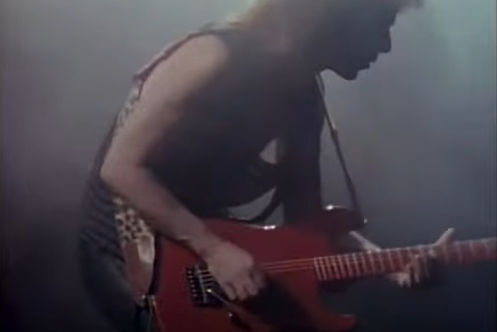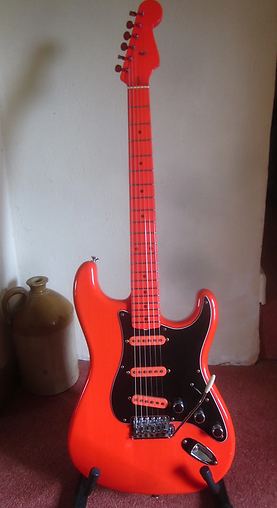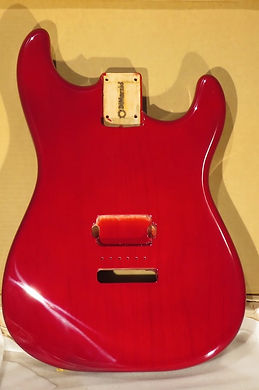The Story Behind The Red Cellophane Guitar
From Steve Lukather to Earl Slick


'Earl's Take' 1983
One day I was watching some old live "Serious Moonlight Tour" David Bowie videos on YouTube. I remembered the story of how in 1983 Bowie happened to get SRV on lead guitars duties, but a few days before tour he was let go from the band. I had written these '83 live versions off because, 'hey, whoever they had playing these parts was going to be no Stevie Ray'...Much to my dismay these lead parts were being played differently, yes...but with just as much heart and soul. Some of the solos with even more bravado than the studio versions. To make a long story short, Earl Slick had been brought on to play this tour. Slick has a long history with Bowie starting in 1974 and was chosen to be in John Lennon's backing band for his 1980 "Double Fantasy" album and tour amongst other high profile projects. The man is a legend, however we are here to talk about the 'Red Cellophane' guitar...so let us begin.
Prior to the tour, Slick had a long running endorsement deal with DiMarzio. Manly known for their high quality pickups, DiMarzio was also in the business of supplying essentially any aftermarket guitar part needed to customize your guitar. Back in the late '70s, companies like Schecter, Mighty Mite, Charvel, and others were rapidly gaining steam at the pro level. DiMarzio never specifically offered pre-built guitars, but you could order bodies, necks, or other parts as needed to build a complete guitar. Slick had come out to L.A. after Lennon's '81-'82 tour had been cancelled due to the musicians death, and Slick was actively looking for gigs and work. Sometime in 1983, Slick took delivery of the parts needed to build a custom guitar he would ultimately be seen playing during his high profile gigs around the world.
Steve Conrad of Valley Arts would later recall the story of building Slick's first all red guitar.
"Larry Dimarzio sent Earl the raw Neck & Body. I befriended Earl in 1981 after he arrived in LA seeking a gig (he was scheduled to tour with John Lennon in 1981). Earl delivered the parts to me summer of 1983 when I was at Valley Arts, where our crew painted Neck & body and I assembled & did the final setup and he took delivery August 1983. About 1 month after delivery, Earl vanished - only to appear with David Bowie (instead of SRV) labor day weekend at the 1983 "US Festival". In reference to the building process Steve remarked "We just shot 100% Red Nitrocelulose Lacquer, even on the Fretboard. ( We did use clear over the fretmarkers / side markers) It was a stock 1982 Dimarzio maple neck / maple fretboard with a '57 V profile with 21 frets. The Dimarzio Maple Strat Neck ( which I own one myself) was a superb "clone" of a 1957 Fender Strat V shape profile. The Red Strat Guitar I built for Earl Slick employed all Dimarzio 1982 era parts: Dimarzio Steel saddle Tremolo Bridge with tighter " Gibson " E to e string spacing and Dimarzio PAF Pickup, 500k Vol Pot and light weight low mass Dimarzio Tuners (which cloned the 1960 vintage Kluson Tuner Post height)."
During a follow-up Steve makes it clear, "Earls Guitar is NOT a MIJ Cellophane Strat - Although I heard Larry DiMarzio was knocked out with Earls Guitar and had similar guitars at 1984 NAMM and the Japanese had a ready market for this type guitar after Bowie's Serious Moonlight tour."
So should we give credit to Slick's vision and Steve's building skills for bringing the Red Cellophane guitar to market? Slick was at least partially responsible for the American catalyst (Along with DiMarzio production and Slick's MTV friendly band with ex-Stray Cats memebers in 1985)- but there is an even older visionary that planted the seeds to the explosion of painted fretboards and solid color guitars of the mid '80s.
K. Nyui worked for Moon Guitars in Japan during the late '70s. At the time Moon and parent company PGM were the primary importers of US Schecter Guitar Research products and parts to Japan. To show gratitude for artists touring Japan at the time, PGM would build and assemble a guitar to present to the band to be played for a song during a concert, in exchange PGM would be able to photograph the artist playing their product, and the artist would get to keep the guitar.
The red guitar that was handed to Steve Lukather when he first came to Japan in 1980 was used for a televised performance of their first single off their 2nd album "99". The guitar, which was thought to be made by Schecter (and promoted in advertisement as such), was actually not made by Schecter but later released as a model made by Moon. Mr. Nyui of PGM (who is still in charge of MOON's production), was groundbreaking at the time. At that time, Mr. Nyui devised a epoch-making strat that became the basis of today's component guitars, such as "22F brim" and "400R fingerboard"!! It is said that the 22F "Tsubadashi" was a big trigger for becoming a standard spec worldwide. The first Valley Arts guitar that Luke ordered from Mr. McGuire in 1978, the "Mahogany Tobacco Sunburst", which was later robot-painted, was originally equipped with Schecter pickups (F500T x3). , seems to have been manufactured by Schecter's assembly. Luke, who used Gibson guitars such as LPs at that time, liked this 22F, 400R ST style guitar at once and started using it regularly. The album "TURN BACK" was released the year after their first visit to Japan. , and as a result, a new guitar sound that was very different from the previous albums was released to the world. This time, Mr. Nyui was troubled reproducing the finish of the pick guard made of brass. It is said that Mr. Nyui repeated the experiment for a period of one and a half months until he reached a satisfactory degree of perfection.
So we're starting to see where all of this comes together. The Japanese (specifically Mr. Nyui's vision and gratitude for Toto's trip to Japan), and Bowie's pop-culture excitement for hit songs "China Girl" and Let's Dance" propel the Red Cellophane Guitar into the stratosphere. In the meantime there is competition brewing in the Japanese guitar market.
ESP had gotten the leg up on PGM/Moon by releasing their own Lukather inspired Red Guitar as a Navigator Custom Guitar in 1981. Angered by lack of artistic respect, Schecter files legal paperwork against ESP (remember Schecter and PGM/Moon are partners) to stop them from producing copies of their guitars including the Red Lukather Guitar. However by 1984, Schecter is having financial problems and it is presumed these legal dealings are dropped or resolved. In the meantime ESP has produced several Red Lukather inspired guitars under the Navigator name and has also begun producing guitars for other manufactures. One of those manufactures is DiMarzio. Seizing the opportunity from Bowie's global appeal and success, and utilizing their lucrative and high profile partnership with Earl Slick, DiMarzio decides to showcase these Red Guitar components in their 1984 Catalog even throwing a reproduction of Slick's guitar on the front cover. These guitar components would be offered from 1984 to 1987. Additionally, ESP would also be breaking into the US market at this time and began to offer their branded Red Cellophane guitars as "The Mirage" and "Mirage Standard" guitars- also including fully Blue Cellophane guitar as well. These would essentially be the same guitar in various pickup offerings but available fully built whereas DiMarzio would only sell you the components in parts.
Phantom, Rocker and Slick emerged from the wreckage of a recently disbanded Stray Cats and Earl Slick never getting that call back from Bowie to work on his followup. The first 20 seconds of Phantom, Rocker and Slick's first music video "Men Without Shame" looks like a DiMarzio commercial. You couldn't ask for a better introduction to these 'New for the '80s' flashy Red Cellophane guitars! Simultaneously, Rick Nielsen of the band Cheap Trick was seen in their music video for "Tonight it's you" playing a DiMarzio Cellophane guitar (this one was in their Neon Pink option) but sill looked red for the camera. Pretty soon their was an explosion of DiMarzio parts being sold. Guitarist from all over the country wanted this new guitar look. ESP hadn't really promoted their own branded Cellophane guitars so this was DiMarzio market to plunder off of. In the far east Japan only manufactures Morris and ESP were churning out their Cellophane inspired guitars by the dozen. Bill Lawrence, Westone, Ibanez, Vintage all sported similar painted necks and bodies. Following a surge of success from their 1982 album IV, Toto had a growth of international stardom and we're a global hit everywhere. Inspired by this success, Fernandes arranged a partnership with guitarist Steve Lukather for two signature guitars. One inspired by his Valley Arts customized '60s era Strat, and a familiar friend. His 1980 Red Moon guitar!


'Steve's Take' 1980


'The ESP/DiMarzio Connection' 1984

'MTV and the rise of the music video' 1985

'The Fernandes Lukather Connection' 1983-1986


'The Complete Red Cellophane Guitar Collection'
Believe me, it was not easy tracking all of these guitars. Most have been sold on Reverb over the years, some were showcased on Blogs, and some slipped through the cracks of time as regular old Strat copies! I've managed to get a hold of a few and plan to sell off some as time permits. Welcome to the insanity!



1984 NAMM Prototype 1986 Guitar Player Magazine Guitar Kit Build



Brad Gillis Owned 1984 ESP Mirage Rick Nielsen Style



1983 Fernandes FST-70H Custom 1985 Rick Nielsen's Pink Dimarzio 1984 ESP Catalog Mirage



1986 Shock Wave Model Red On Red Custom 1984 NAMM Prototype
'My Project'
